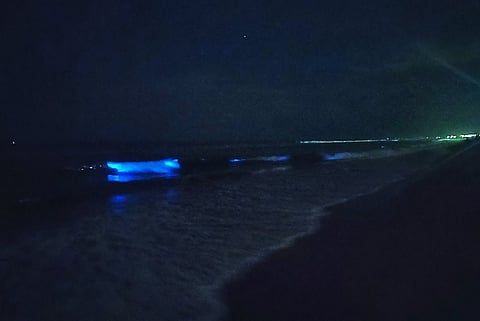

The presence of bio luminescence or sea sparkles in the waters at beaches along the East Coast road near Chennai, left passers by in awe on Sunday. Several walked over the sands, to the sea to get a closer look at the bluish, almost ethereal glow emanating and reflecting into the night.
Observers, immediately took to social media to post pictures and videos of the phenomenon and to understand better what they were looking at.
2 hours of just sea gazing pic.twitter.com/QNsSHrx2z9
— Livowksi (@ajaw_) August 18, 2019
When I was moving to this beautiful city 4 years ago, the only promise I made to myself was that I would always live by the beach.
— MadMax (@TapiocaChip) August 18, 2019
Tonight was the best validation I could have received for this choice pic.twitter.com/S4H1PDxqvZ
Bioluminescence in #Thiruvanmiyur beach #chennai pic.twitter.com/MBkwtTdwn6
— Sundar G (@SunOfGan) August 18, 2019
The bio luminescence had become a point of discussion after it was also featured in the Malayalam movie 'Kumbalangi Nights' last year. At that time, Dr Gulshad Mohammed, a Principal Marine Scientist with Central Marine and Fisheries Research Institute (CMFRI), Kozhikode, had told TNM that the phenomenon was very rare. The ‘magical glow’ is caused by a high concentration of a micro-plankton called Noctiluca scintillans in the sea.
While the sparkle is similar to the fireflies’ glow, the micro-plankton itself cannot be seen by the naked eye as it’s a micro-organism. He stated that while the odds are rare, bio luminescence may also be sighted in estuaries and brackish waters where sea water intrusion happens.
"It is more common in Japan, California in the US and in South American coasts. It is rarely sighted in our coasts, perhaps due to the tidal amplitude. Tidal amplitude disturbs the concentration. For the glow to be visible, there should be a very high concentration, with millions of the particular plankton species coming together. This happens in relatively calm waters. As the life cycle of Noctiluca is just about a day, the sighting would also last only for a few hours or a day," he stated.
However, Pooja Kumar from the Coastal Resource Centre states that while the sights are awe-inspiring and beautiful, it is not necessarily a reason to celebrate.
"Notiluca is an algae which thrives in areas where there is an oxygen deficit and it points to lack of marine health in the particular area. This blue-green Notiluca also emanates ammonia and eats diatoms, a kind of plankton, which fish depend on food as well," she says.
Pooja adds that a one off spotting is not a reason to be concerned. "In places like Oman and Tanzania, they have found it for weeks and it leads to fish kills and creates a temporary death zone which drives fish away," she adds.
When asked what the cause for the appearance in Chennai could be, she states that it cannot be determined without further investigations.
"It could be due to excess run-off due to the rain or lack of oxygen in that particular area due to multitude of reasons. There have also been studies that show that the warming of oceans could be responsible for the spotting of bio-luminescence. If that is the cause, it is a cause of worry and should be investigated further," she says. "We will however be looking whether there is fish kill. And if it is not recurring it is not a cause of worry."